Dairy Animations
Back to: Victorian Dairy Soils
A series of animations are provided to show processes relevant to soil and landscapes with a particular focus on agricultural systems and landscapes. The 'back' button can be used to navigate back to this page.
| Carbon cycle animation Carbon is essential to life on earth, with every living organism needing carbon to sustain life whether for physical structure, or as an energy source, or both. This animation shows the carbon cycle from an agricultural prospective. | 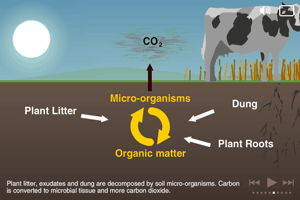 A scene from an animation explaining the soil carbon cycle |
| Nitrogen cycle animation Approximately 78 % of the earth's atmosphere is nitrogen, however, atmospheric nitrogen is unavailable for biological use. Atmospheric nitrogen must undergo an important process called fixation to make it available for plants to use. The animation shows the nitrogen cycle from an agricultural perspective. In an agricultural system, carbon is cycled through the atmosphere, through plants and animals, and through the soil. The production of food affects the amount of carbon in the soil as harvesting plant and animal products removes carbon from the agricultural system. Increasing the amount of carbon stored in the soil can contribute to offsetting the amount of CO2 in the atmosphere as well as improving the health of our soil. | 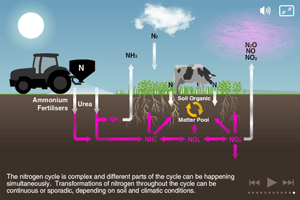 A scene from an animation showing the nitrogen cycle |
| Soil phosphorus cycle in grazing systems Productive agriculture depends on the availability of soil phosphorus (P). This animation shows how transformations of P in the soil are just one part of a complex cycle of P through soil, water and living organisms. A better understanding of how P cycles in an agricultural environment can help us better manage P fertiliser inputs and reduce excess P losses. | 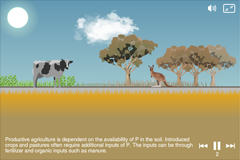 Animated scene showing the soil phosphorus cycle in grazing systems. |
| Soil phosphorus cycle in grazing systems This animation shows soil phosphorus (P) within the context of a farm and agricultural landscape. At the farm scale, soil P levels are affected by fertiliser and feed imports on to the farm and removal of crops and animal products off the farm. P levels are often unevenly distributed within the farm landscape and influenced by management practices. | 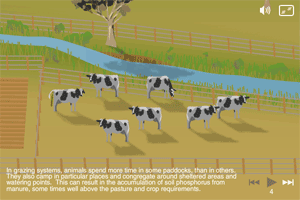 Animated scene showing distribution of soil phosphorus in the agricultural landscape. |
| Acidification animation The acidification of agricultural soils is a common problem in some areas. This animation provides a simple illustration of the complex process of soil acidification in an agricultural context. Agriculture often decreases the pH of soil through everyday practices such as harvesting hay and grain, applying fertilisers, and cropping with legumes.It is important that soil pH is regularly measured and monitored to ensure remedial action is taken to prevent strongly acidic soils from developing. The animation also shows how aluminium and manganese toxicity can be a major constraint to plant production on strongly acid soils. | 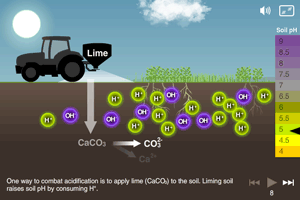 A scene from the soil acidification process animation |
| Sub surface drip irrigation animation Subsurface drip irrigation (SDI) systems involve the placement of permanent drip tapes below the ground surface to supply water directly to the crop root zone. The animation shows how a SDI system from a dairy agricultural perspective. This animation shows how a surface drip irrigation system works. | An animation showing how a subsurface drip irrigation system works |


